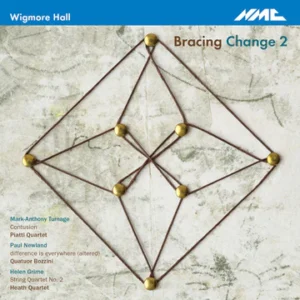Bracing Change 2
Piatti Quartet, Heath Quartet, Quatuor Bozzini
NMC Recordings
The first Bracing Change recording dates from 2017, when Wigmore Hall decided to use the moniker as the title for a series of string commissions. Three string quartets play on Bracing Change 2, another collection of commissions by the organization.
The Piatti Quartet plays Mark-Anthony Turnage’s “Contusions.” It begins with sforzando punctuations of a modal ostinato, gradually picking up steam, accumulating material, and more dissonant harmonies along the way. An emphatic and knotty passage of counterpoint marks the end of the first large section, after which there are viola and cello solos trading angular melodies. The upper voices join, creating a duo cadenza. A new ostinato, this one more emphatic and motoric in feel, accompanies snatches from the various solos. Full-throated tremolandos lead into the final section, a suddenly subdued passage of a third type of repeated patterning. The swells from the opening, this time forte, join the rest of the material to create a sense both of return and greater intensity. A final melody in the cello is accompanied by harmonics and tremolandos, and the chords from the piece’s opening, this time subdued. A brash vertical ends the piece conclusively.
Quatuor Bozzini plays Paul Newland’s “Difference is Everywhere,” which combines slow-moving mixed interval chords with sustained single notes at a soft dynamic. Bozzini are some of the best exponents of the Wandelweiser Collective, so this is right in their wheelhouse. Newland’s music may adopt Wandelweiser signatures, but “Difference is Everywhere” is a distinctive and attractive piece.
Helen Grime’s String Quartet No. 2 is a major work in her catalogue. The Heath Quartet’s rendition is detailed in terms of articulations, special techniques, and dynamics. The first movement combines tremolandos and mixed interval chords. Gradually these build in dynamic, replaced by quick-paced lines juxtaposed with pizzicatos. A syncopated gesture asserts itself as a principal motif, which is followed by a soft interlude of trills versus sustained notes. Fleet forte scalar passages create a vigorous coda. The second movement also features pizzicatos and the syncopated gesture found in the first. The latter is played fortissimo and surrounded by glissandos. A doleful melody, sliding between pitches, begins the final section in which previous motifs are played in a long decrescendo to a hushed close. The third movement begins with a near-continuation, with intricate harmonies accompanying a brisk violin solo. Verticals continue on their own, and the sliding melody from the second movement makes an altered reappearance with pizzicato punctuations. Glissandos and trills build a hive of dissonance, its buildup then replaced by undulating arpeggios. Swelling harmonies move from mixed interval chords to ones that orient the piece closer to minor. A long decrescendo of fragments of melody and sustained chords completes the movement, and the piece. The quartet is a worthy successor to Grime’s Quartet No. 1.
Bracing Changes 2 lives up to its title, but there is a significant amount of variety among the pieces. It is one of my favorite releases of 2023.
Christian Carey

